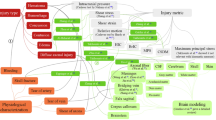Abstract
A head injury model consisting of the skull, the CSF, the brain and its partitioning membranes and the neck region is simulated by considering its near actual geometry. Three-dimensional finite-element analysis is carried out to investigate the influence of the partitioning membranes of the brain and the neck in head injury analysis through free-vibration analysis and transient analysis. In free-vibration analysis, the first five modal frequencies are calculated, and in transient analysis intracranial pressure and maximum shear stress in the brain are determined for a given occipital impact load.
Similar content being viewed by others
References
Hosey, R. R., andLiu, Y. K. (1982): ‘A homeomorphic finite element model of the head and neck’in ‘Finite elements in biomechanics’Gallagher, R. H., Simon, B.R., Johnson, P. C., andGross, J. F., (Eds.): (Wiley) pp. 379–401
Hubbard, R. P., andMcLeod, D. G. (1974): ‘Definition and development of a crash dummy head’. Proc. 18th Stapp Car crash Conf., paper 741193
Khalil, T. B., andHubbard, R. P. (1977): ‘Parametric study of head response by finite element modelling’,J. Biomech.,10, pp. 119–132
Kumaresan, S. (1994): ‘A three dimensional finite element analysis of human head with and without protective system’, MS Thesis, Indian Institute of Technology, Madras, India
Kumaresan, S., Radhakrishnan, S., andGanesan, N. (1994): ‘Generation of geometry and discretization of closed human head for finite element analysis’,Med. Biol. Eng. Comput.,33, (3), pp. 349–343
Ruan, J. S., Khalil, T., andKing, A. I. (1991): ‘Human head dynamic response to side impact by finite element modeling’,ASME Trans., J. Biomech. Eng.,113, pp. 276–283
Ruan, J. S., Khalil, T. B., andKing, A. I. (1994): ‘Dynamic response of the human head to impact—by three dimensional finite element analysis’,ASME Trans., J. Biomed. Eng.,116, pp. 44–50
Ward, C. C., andThompson, R. B. (1975): ‘The development of a detailed finite element brain model’. Proc. 19th Stapp Car crash Conf., pp. 641–674
Ward, C. C., Nikravesh, P. E. andThompson, R. B. (1978): ‘Biodynamic finite element models used in brain injury research’,J. Aviat. Space. Environment. Med., pp. 136–142
Author information
Authors and Affiliations
Rights and permissions
About this article
Cite this article
Kumaresan, S., Radhakrishnan, S. Importance of partitioning membranes of the brain and the influence of the neck in head injury modelling. Med. Biol. Eng. Comput. 34, 27–32 (1996). https://doi.org/10.1007/BF02637019
Received:
Accepted:
Issue Date:
DOI: https://doi.org/10.1007/BF02637019




